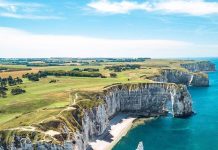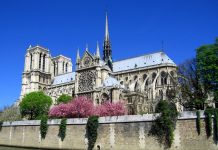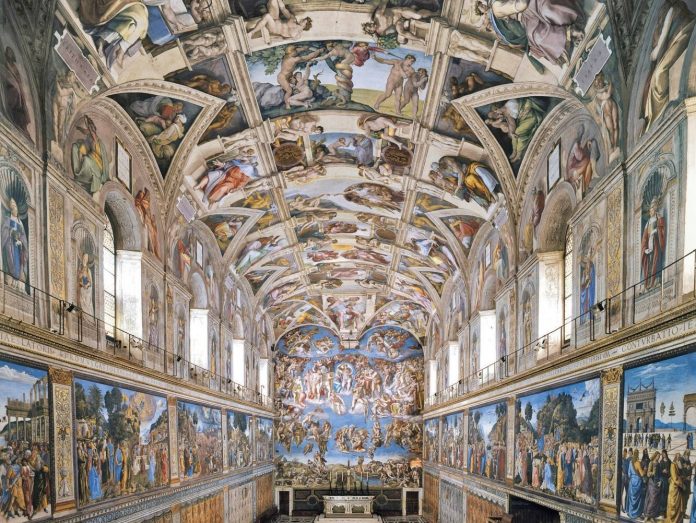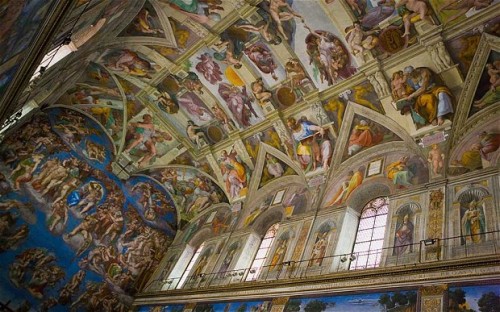Not only is the Sistine Chapel a wonderful building, but the preservation of beautiful and intricate works of art make it truly fascinating. The Sistine Chapel is slightly off-centre near the middle of the city, and is an essential stop to any trip to Italy. It was built from 1473 to 1481, and was officially consecrated in 1483.
The Sistine Chapel is just one chapel in the Apostolic Palace where the Pope resides. The Chapel used to be called Cappella Magna but had a name change in 1477. From this time to 1480, Pope Sixtus IV had it restored.
The Chapel is not only a religious place of worship, but a popular stop on any Italian tour itinerary. It’s an excellent example of Renaissance architecture and painting.
While the Sistine Chapel has some intricate architecture and other beautiful works of art, including sculptures and artifacts, it’s the colorful and bright religious wall and ceiling paintings that make people stare. And not only are these paintings some of the best examples of art from that era, but most of them were done by the leading painters of the time too.
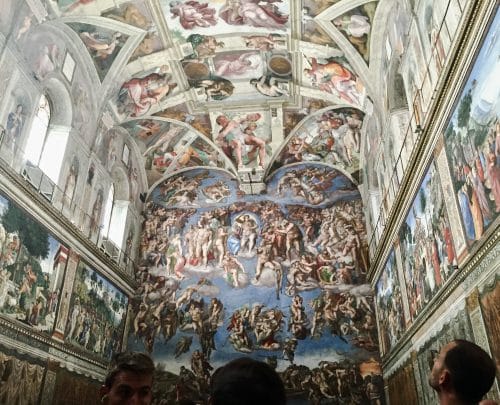
Without the efforts of the Popes and clergy who supported the Chapel, it wouldn’t be around today. It can seem quite amazing that all the priceless works of art that cover the ceilings and walls can still be in such wonderful condition, and should be around for our successors to enjoy for hundreds of centuries ahead.
What Is a Fresco?
The paintings that cover the walls are called frescoes, meaning “in the air”. This is what the Italians called the painting of murals on wall or surface. A fresco is first prepared by setting a wet lime plaster on the surface. The paint is then applied. Finally, water is applied, which allows the pigment to merge with the surface of the plaster. Once it sets, the painting becomes more permanent.
You can imagine that if it was simply a painting on top of a surface, how the paint would have chipped off and wouldn’t have survived intact all these centuries. With this fresco technique, the paint has settled deep into the plaster.
But just because this technique was used, doesn’t mean that the paintings haven’t needed a bit of restoration and maintenance over the years.
How the Paintings Began
Inside the Chapel are six windows on each side, and two at each end. If you look at older drawings of the Sistine Chapel, the walls are covered, but the ceiling is bare. The ceiling is like a barrel shape and encircles the walls at each of the window arches so there are no harsh lines like in your standard modern building.
Even though there were no paintings on the ceiling yet, it was still painted in a brilliant blue color. Piermatteo d’Amelia created a design of gold stars over the deep blue sky. There were also decorative borders painted around the architectural details of the interior.
A team of Renaissance painters were contracted during the time of Sixtus IV. These included the notable Sandro Botticelli. You may not be as familiar with these other painters, but they too have notable works in the Chapel. Pietro Perugino, Cosimo Roselli, Domenico Ghirlandaio, and Pinturicchio were all commissioned to create what is now called “The Life of Moses”, and “The Life of Christ”. These are located above papal portraits in the Chapel.
This series of paintings was finished in 1482. After the paintings were done, the first mass was held in the Chapel for the Feast of the Assumption, where the Chapel was consecrated and dedicated to the Virgin Mary.
Most Popular Renaissance Painter: Michelangelo
Perhaps one of the most important and notable paintings of the Sistine Chapel has to be the one on the ceiling. While it would be fantastic to see the original ceiling painting of the Chapel and its decorative borders, eventually Michelangelo was commissioned to paint his fabulous historical stories upon the ceiling. Initially, he did not want to take the commission, as he was a sculptor. It was also a large undertaking, on an awkward surface—to repaint the entire ceiling of the Sistine Chapel. He couldn’t understand why they wanted him for this project.
It actually took him four years to complete—from 1508 to 1512. This was under the direction of Pope Julius II. Not only did this painting change the history of art as we know it, but it’s an incredible artistic accomplishment that hasn’t been repeated since then. Plus, the tricky aspect of painting a ceiling can just boggle the mind.
For his first paintings, he was supposed to paint the twelve apostles on the instruction of Pope Julius II, but demanded artistic licence. And it’s a good thing he did, because what he created was fabulous.
Michelangelo’s First Paintings in Sistine Chapel
It was a challenge for him to create these paintings, as he had to reach the ceiling first. He first needed a support or scaffold. Initially, it was to be suspended in the air with ropes, but this resulted in damage to the ceiling. Eventually, he built his own scaffold, with a flat wooden platform on brackets. These were attached to holes in the wall.
Michelangelo actually stood up as he was creating the paintings on the ceiling. He did not lie down on the scaffold according to pop culture references.
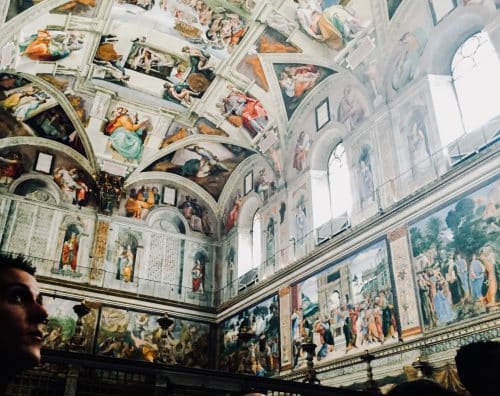
His first commissions for the Sistine Chapel were a series of nine pictures which cover the triangular pendentives that support the vault or ceiling of the building. These paintings include: Mankind’s Fall from God’s Grace, God’s Relationship with Mankind, and God’s Creation of the World.
Over the larger pendentives he painted twelves paintings of classical and biblical people that had prophesied that Jesus Christ would come. Around the upper parts of the windows he painted the Ancestors of Christ.
The Last Judgement
Perhaps the most popular fresco Michelangelo has ever painted is the one called the Last Judgement. This painting took a bit longer, as he worked on it from 1535 to 1541. It was commissioned by Pope Clement VII and Pope Paul III.
Even though it’s been over five hundred years now, his paintings continue to be a major draw to the Sistine Chapel.

Raphael’s Paintings
The Sistine Chapel isn’t just about Michelangelo though. There were numerous painters commissioned to make paintings. Perhaps second in popularity is Botticelli, but Raphael is also a well-known Renaissance painter and architect that had a major role in the art of the Sistine Chapel.
His medium differed a bit though, so instead of painting the ceiling or walls, he was commissioned to design a series of ten different tapestries. These would be hung around the lower tiers of the walls.
His first set of tapestries included the Life of St. Peter and the Life of St. Paul, both of whom were the founders of the Christian Church in Rome. He began his work in 1515.
The tapestries were made in Brussells and were quite large. It took four years for weavers to complete them all. Pieter van Aelst owned the shop that created them.
Sadly, all of Raphael’s tapestries were stolen during the Sack of Rome in 1527. They were burnt to extract their precious metal content. Others were sold throughout Europe.
During the late 20th century, a new set was reassembled from random pieces not used during the creation of the first set. These were once again displayed in the Sistine Chapel in 1983. Today they are brought out for special ceremonies. It’s unknown what happened to the surviving tapestries, but perhaps one day, one may be found.
The Stories of the Wall Frescoes
By now most people will understand that these are simply not paintings that line the walls and ceiling of the Sistine Chapel, but stories. These stories are related to stories from the Bible, especially the Old Testament. These paintings were done from 1481 to 1482.
Along the southern wall of the Chapel are a series of paintings that depict the Stories of Moses. Botticelli painted the Trials of Moses and the Punishment of the Rebels. Perugino painted Moses Leaving to Egypt.
Along the northern walls are the Stories of Jesus, including the Baptism of Christ by Perugrino, and the Sermon on the Mount by Cosimo Rosselli.
The eastern walls have the Resurrection of Christ by Hendrick van den Broeck in 1572, and Disputation over Moses’ Body by Matteo da Lecce.
Add the Sistine Chapel to Your Bucket List
Everyone has that bucket list in their mind—see the Pyramids, bathe in the Dead Sea, and visit the Sistine Chapel to see those fabulous paintings up close. Viewing them in a book or on TV just isn’t the same. If you’re planning a trip to Italy, be sure to add the Vatican City to your travel itinerary.
You’ll be amazed at all the beautiful art and paintings in the Sistine Chapel that likely won’t be duplicated any time soon!

